Today’s edition of Corriere dello Sport compares the squad value of Milan and Inter and the money spent to build them. Based on Transfermarkt data, both indicators favor Inter. Chivu’s squad is worth 222 million more, yet if you look only at transfer fees, it cost 97 million euros less. The balance sheet tells a different story because gross wages also shape squad cost, and Inter are far above Milan on that front.
This situation comes from the spending needs and limits of the two clubs. During the Suning years, Marotta and Ausilio worked with tight margins, free transfers and clever ideas, without lowering the squad’s level. Inzaghi added strong work, raising the output of the players he had.
Milan relied on clean accounts, a positive balance sheet and stronger spending power to invest heavily in transfer fees. They lacked a clear plan. Each summer felt like another overhaul, as shown by the long list of deals in the latest window. One club offered continuity, the other constant change. The difference showed on the pitch.
Milan stayed near the top, yet last season ended with a disappointing eighth place and a year out of European competitions. Even with no Champions League income, the approach of Elliott first and RedBird after allowed Milan to push through a strong transfer window and adjust some guidelines. Modric and Rabiot arrived with experience, and the club spent close to 35 million on Jashari and Nkunku. This marked a clear break from recent years, driven by the need to change course and cut the gap seen on the pitch.















